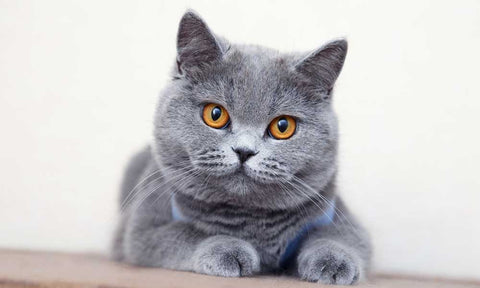Is our number one priority
British Shorthair

Cat with a smiley face and chubby cheeks
The British Shorthair cat breed is native to the United Kingdom. According to history, this breed's ancestors came from the Roman Empire, where they were kept as pets and also used to hunt rodents. The Romans transported them to northern Europe and eventually to the British Isles.
Harrison Weir, a cat fancier, is credited with establishing this breed. His efforts resulted in the showing of the British Shorthair in England's first cat show in the late 1800s, and this cat quickly became popular after that.
Interbreeding between the original breed and Persians and other shorthaired breeds, such as the Chartreux, led to the current iteration of the British Shorthair. Various groups recognized the British Shorthair between 1970 and 1980.
Characteristics
This strong, muscular cat has a small, evenly proportioned square-shaped body. He has a big chest, a large, round head, and plump cheeks.
The British Shorthair's eyes are distinctive. They are big, rounded, and far apart. The hue varies depending on the coat color of each cat. Copper and gold are the most typical colors.
The ears are medium in size, broad at the base, and have rounded tips. This cat has robust, rounded paws. His tail has a medium length with a rounded tip.
The coat is short, dense, and waterproof. There is no double or woolly coat, but it does break over the contours of the British Shorthair's body. Coat colors vary with the exception of chocolate, lavender, the Himalayan pattern, and a combination of these colors and white.
Male British Shorthairs are larger than females. His weight is 5-10kg, while hers is 5-7kg. In addition to the obvious size difference, the adult male has prominent cheek jowls.
The lifespan of the British Shorthair is 13 years.
Personality
The British Shorthair is a laid-back cat. He is calm, even-tempered, and not at all demanding. He, on the other hand, makes an excellent loyal companion.
This cat is sweet and affectionate to all of his family members and is great around children. He is rarely irritated and tolerates physical interaction.
The British Shorthair is self-sufficient and adapts well to any home environment. He prefers to stay indoors, making him ideal for apartment living.
This cat is intelligent and easy to train. Because of his ability to learn small tricks, the breed has been used in modern-day films and television commercials.
Care
The short coat doesn't require much grooming. Because the British Shorthair is not very active and prefers to stay indoors, he rarely requires cleaning. This cat sheds heavily in the spring, necessitating a thorough brushing once or twice a week to remove dead hair.
Oral infections can be avoided with proper dental care. Spread PlaqueOff on top of your cat's food to prevent plaque buildup. For added protection, use dentifresh spray on your cat's gums on a daily basis.
In order to maintain the British Shorthair's naturally attractive appearance, the huge, round eyes should be kept clean. While looking for mites that provoke excessive scratching, dirt should be kept away from the ears.
To avoid injuries, the British Shorthair's nails should be trimmed. This is assuming they don't fall off on their own. Nail cutting is a delicate process that should be done with extreme caution to avoid cutting into the root.